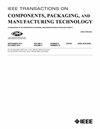低成本三维封装用聚酰亚胺绝缘体无势垒铜互连方案的实验研究
IF 3
3区 工程技术
Q2 ENGINEERING, ELECTRICAL & ELECTRONIC
IEEE Transactions on Components, Packaging and Manufacturing Technology
Pub Date : 2025-03-13
DOI:10.1109/TCPMT.2025.3569685
引用次数: 0
摘要
聚酰亚胺(PI)作为绝缘体材料广泛应用于三维先进封装的铜互连系统中。一般来说,在PI和Cu之间需要一个势垒层来抑制Cu的扩散,这增加了制造成本和复杂性。在本文中,我们实验研究了在省略典型阻挡层的情况下,采用PI绝缘体的无阻挡铜互连方案的可行性。利用能量色散x射线光谱(EDX)和傅里叶变换红外光谱(FTIR)测试对溅射Cu在PI中的扩散现象进行了评价。结果表明,在$300~^{\circ}$ C下退火1 h后,具有足够厚度的PI层可以防止Cu原子扩散到Si衬底中。基于Cu - PI - Si结构的电学测量结果表明,在不同的测试温度下,泄漏电流相对较小,并且退火后PI的绝缘性能几乎没有下降。此外,进行了时间相关的介电击穿(TDDB)测试,估计在电场小于1.45 MV/cm或1.25 MV/cm时,PI在退火前或退火后的平均失效时间(MTTF)分别超过十年。因此,所提出的PI绝缘子无阻挡铜互连方案在绝缘性能和长期可靠性方面是可行的。该方案通过低成本的制造流程进一步实现在垂直通硅孔(TSV)结构中,在漏电流和寄生电容方面都表现出良好的电性能。本文章由计算机程序翻译,如有差异,请以英文原文为准。
An Experimental Study on a Barrier-Less Cu Interconnect Scheme With Polyimide Insulator for Cost-Effective 3-D Packaging
Polyimide (PI) has been widely used as the insulator material in the Cu interconnect system for 3-D advanced packaging. In general, a barrier layer is required between PI and Cu to suppress Cu diffusion, which increases the fabrication cost and complexity. In this article, we experimentally investigate the feasibility of a barrier-less Cu interconnect scheme with PI insulator while omitting the typical barrier layer. The diffusion phenomenon of sputtered Cu in PI is evaluated by the energy dispersive X-ray spectroscopy (EDX) analyses and the Fourier transform infrared spectroscopy (FTIR) tests. It is revealed that the PI layer with sufficient thickness can prevent the Cu atoms from diffusing into the Si substrate even after annealing at $300~^{\circ }$ C for 1 h. Electrical measurement results based on the Cu–PI–Si structure show that the leakage currents are relatively small across various test temperatures, and there is little degradation in the insulating performance of PI after annealing. Moreover, time-dependent dielectric breakdown (TDDB) tests are carried out, and the mean-time-to-failure (MTTF) of PI before or after annealing is estimated to be more than ten years for electric fields less than 1.45 or 1.25 MV/cm, respectively. Therefore, the proposed barrier-less Cu interconnect scheme with PI insulator demonstrates feasibility in terms of insulating performance and long-term reliability. This scheme is further implemented in the vertical through-silicon-via (TSV) structure by a low-cost fabrication flow, which exhibits good electrical performance in both the leakage current and the parasitic capacitance.
求助全文
通过发布文献求助,成功后即可免费获取论文全文。
去求助
来源期刊

IEEE Transactions on Components, Packaging and Manufacturing Technology
ENGINEERING, MANUFACTURING-ENGINEERING, ELECTRICAL & ELECTRONIC
CiteScore
4.70
自引率
13.60%
发文量
203
审稿时长
3 months
期刊介绍:
IEEE Transactions on Components, Packaging, and Manufacturing Technology publishes research and application articles on modeling, design, building blocks, technical infrastructure, and analysis underpinning electronic, photonic and MEMS packaging, in addition to new developments in passive components, electrical contacts and connectors, thermal management, and device reliability; as well as the manufacture of electronics parts and assemblies, with broad coverage of design, factory modeling, assembly methods, quality, product robustness, and design-for-environment.
 求助内容:
求助内容: 应助结果提醒方式:
应助结果提醒方式:


